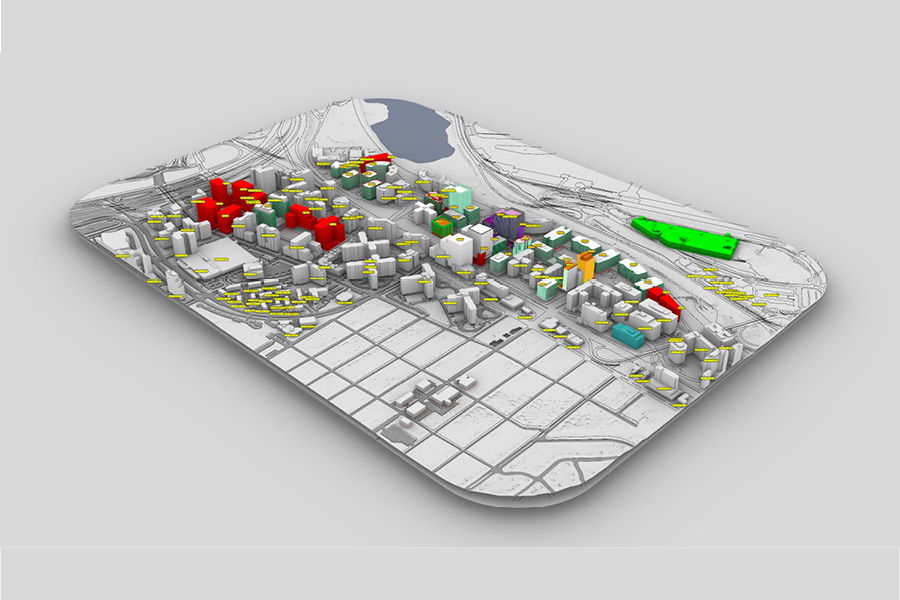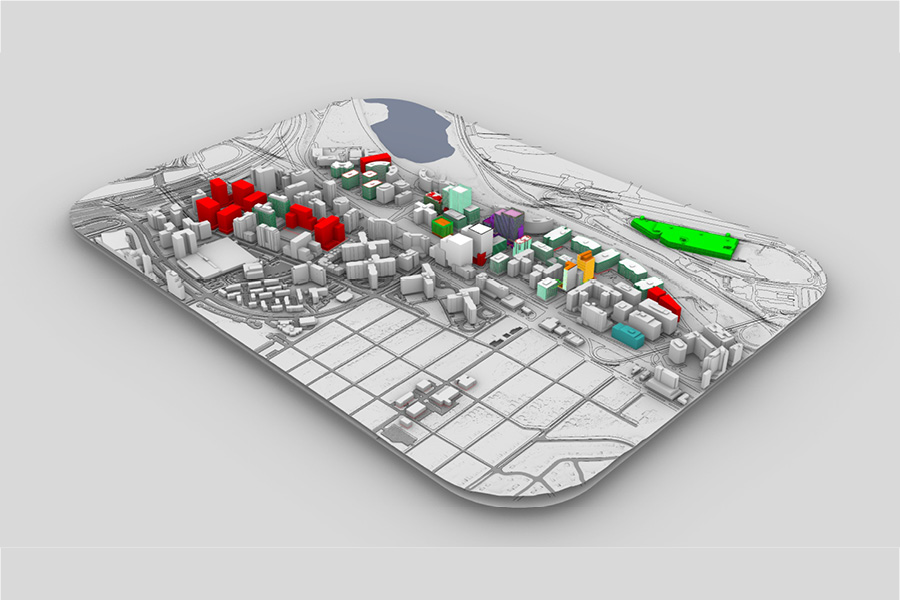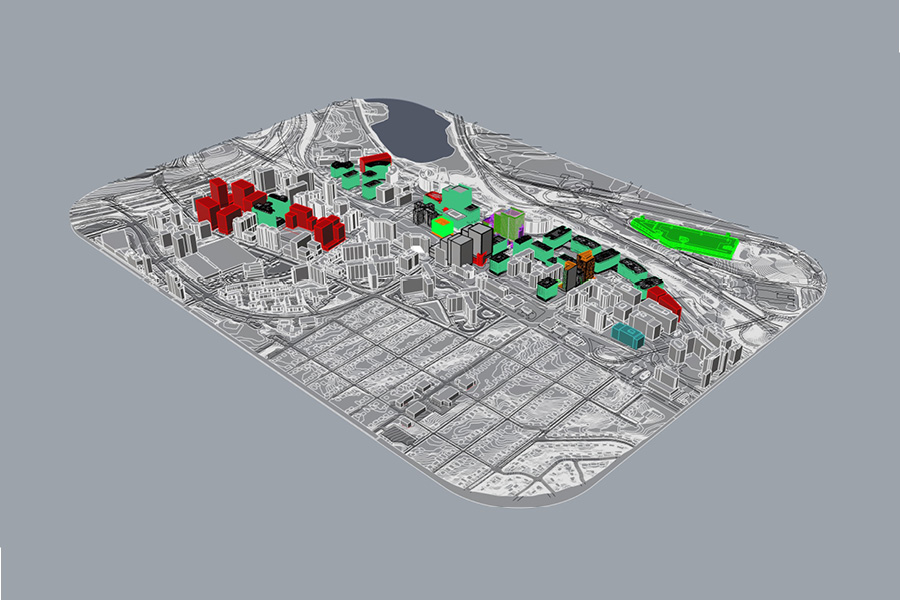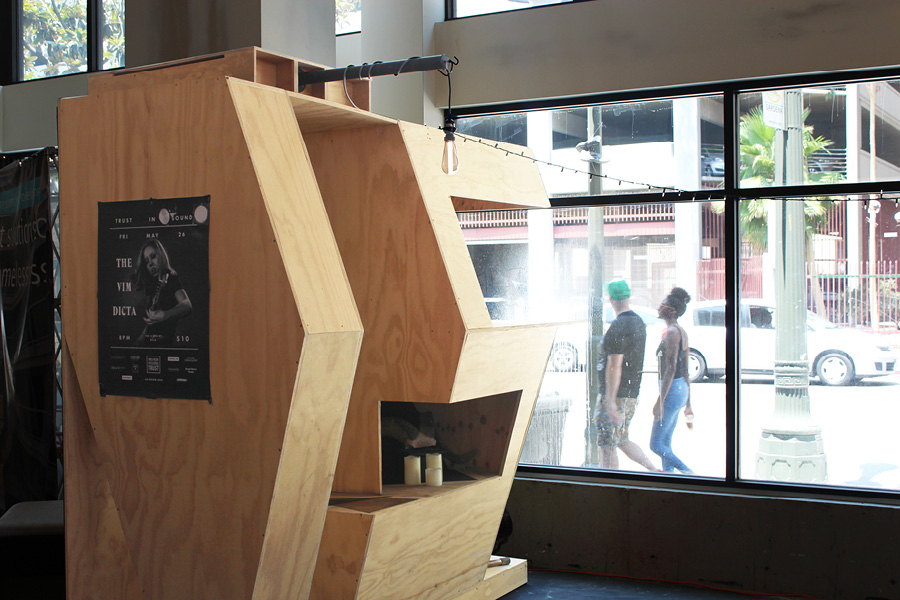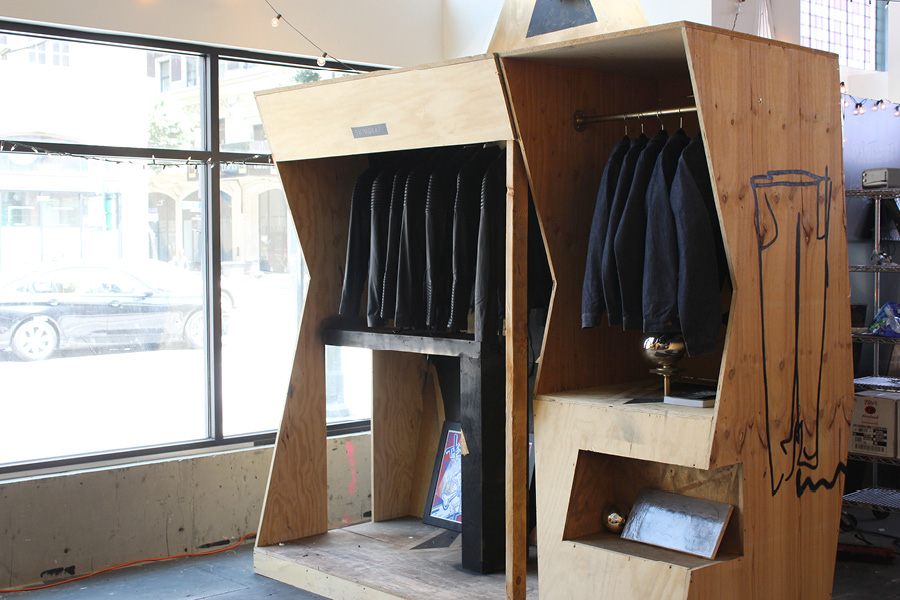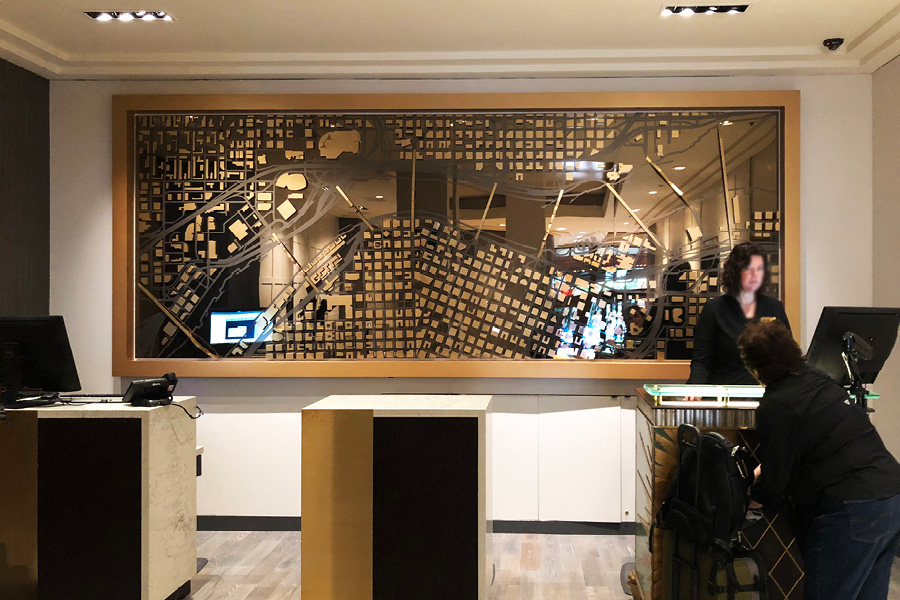SAND DUNE FEATURE WALL
With HansonLA
Completed 2018
This solid walnut feature wall designed for the Circa Towers’ residential condominium lobby in downtown Los Angeles is inspired by the curvature of desert sand dunes. The main challenge for this project was to achieve maximum depth of curvature while maintaining cost effectiveness. Each panel with curvature was manufactured with CNC digital manufacturing which allowed us to achieve 14 inches of depth rising off the wall and a striking visual effect. Panels marked in green are completely flat and produced with traditional woodworking techniques. Panels highlighted in yellow achieve a material height of up to 6 inches and were processed on standard-sized CNC machinery, while only the few panels highlighted in red required processing using specialized equipment. Allowing half of the panels to remain flat and focusing the extreme depths to as few panels as possible allowed us to effectively control cost for this project.
HAYWARD FIELD BOWERMAN MUSEUM
With Gallagher Design
Status: Completed 2021
Bill Bowerman, known as Oregon’s greatest coach and co-founder of Blue Ribbon Shoes, the company that would become NIKE, is honored throughout the Hayward Field project. The museum is located on the campus of the University of Oregon in Eugene and inside the 4,000-square-foot Hayward Hall situated under the east side of the Hayward stadium. The Bowerman Museum pays homage to the great track and field coaches of Oregon, the university’s iconic athletes, and history of athletic achievement through five interactive experiences:
- “Coaches of Oregon” tells the story of the great track and field coaches through Oregon history.
- “Hayward Theatre” is a space to learn about the university and track program through film.
- “The Maker” is a re-creation of Bill Bowerman’s workshop illustrating his work as an inventor.
- “The Roots of Oregon” tells the story of great Oregon athletes, including Steve Prefontaine.
- “Oregon Innovation” speaks to the ongoing relationship of innovation that exists between the University of Oregon and NIKE.
WITHERGREEN FOUNDATION SCHOOL
With Architects Without Borders – Oregon
Status: Design Development
The Withergreen Foundation school is located just outside of Monrovia, Liberia. The organization contacted Architects Without Borders of Oregon to assist with space planning to expand their existing facility. Currently, the school teaches students from kindergarten through 8th grade and the facility includes 7 classrooms, a library, and administrative offices. Our proposal will allow the school to maximize the use of its lot by adding more classrooms, a larger library, a computer and science lab, a cafeteria, kitchen, a play court, gathering space, and faculty dwelling quarters. Phasing is an important part of this masterplan as the school requires more classrooms as soon as possible, while the more structurally complex buildings are designed and constructed. Additionally, there is interest in employing photovoltaic solar panels on site to meet the campus electrical needs and power a deep well that services the school and the surrounding community. We are currently consulting with volunteer structural and MEP engineers to work through the technical challenges of a project located in a region with limited resources.
CRYSTAL CITY SHOWROOM MODEL
With ZGF Architects
Status: Completed 2019
A 14’ x 11’ fully immersive showroom model allows our developer to tell the story of community improvement and infrastructure advancement proposed for Crystal City, Virginia. Every building on the model is uniquely 3D printed and wired with LED lights allowing them to be illuminated individually or as groups of buildings and controlled with a tablet. Because each building is unique, we developed a tracking system to track each building. Our system allowed us to track each building—with reference to its location on the model—through 3D modeling, 3D printing, assembly, LED programing, and eventually client control. Properties of importance were taken a step beyond the clean white 3D printed nylon plastic and are assembled with a second layer of acrylic and MDF to mimic its unique façade fenestration.
SRHT POP-UP SHOP
With HansonLA
Completed 2017
Skid Row Housing Trust is a nonprofit organization operating in downtown Los Angeles. One of their programs "Denim Academy'' affords individuals experiencing houselessness the opportunity to learn skills working with fabrics and textiles. Our firm and contractors collaborated with their organization to design and fabricate a pop-up shop that functions as an apparatus for selling their jackets, jeans, and accessories. The shop lives inside their storefront and can be broken apart and wheeled outside to activate the street, inviting the community to learn about their work and offering people the opportunity to purchase items and support the program. Additionally, the pop-up shop is sized to fit in a standard pickup truck bed and can be spotted around the city of LA at farmers markets, craft fairs, and community gatherings.
BRONZE CITY
With ZGF Architects
Completed 2019
A three-dimensional city model of the city of Portland for a renaissance-themed hotel matches the hotel lobby’s rich bronze finishes and interior scheme. Situated behind the guest services area, the installation serves as a tool for hotel agents to guide guests around the city and point at notable landmarks. Because of the limited time and budget to complete this project, the majority of city blocks are distilled into five standard shapes making up 85% of features represented on the model. Standardizing the buildings marked in green, yellow, blue, purple, and pink allowed us to focus detail into the 15% of buildings marked in red that have unique and iconic shapes loved by the city of Portland.
MUTUA
Southern California Institute of Architecture - 2016
Project Team:
Ryan Odom, Mun Yi Cheng, Caleb Fisher, Fangyuan Hu, Brendan Ho, Anthony Stoffella & Xiangtia Sun
Presented at the Museum of Modern Art in New York City and as a finalist in the BioDesign Challenge, the MUTUA concept won the Autodesk Prize for Best Visualization. MUTUA speculates on a system of robotic panels working in harmony with genetically modified organisms such as slime molds and lichens. What if these organisms could be coded with performative attributes aimed at improving human life? These organisms would alert us about air quality, pollen and allergens, or even early signs of illnesses in people. The robotic arm tends to the organisms living off the panel, applying nutrients where needed and killing unwanted growth. MUTUA offers a fresh, living concept for interior design in the age of bioengineering.
ZOMBIE ARCHITECTURE
Southern California Institute of Architecture - 2016
David Ruy Studio
In collaboration with Anthony Stoffella
“These towers are popping up everywhere and are decimating the skyline of London.”
I am pleased to announce we have been selected to develop several unprecedented luxury residential towers within the city of London. We are revamping London’s skyline with these towers, allowing us the opportunity to transform London back into a great contemporary metropolis of the world.
The towers will offer a range of sky-high condos fitted with Italian marble, solid wood flooring, and floor to ceiling heights that range from 12’ to 20’. Amenities and services feature a private restaurant, an Olympic size swimming pool, a billiards room, a library, and en-suite room service. Designed within the typical construction of residential skyscrapers are the unparalleled executive condos that offer a remarkable amount of luxury space, light, and privacy.
Just as the value of a Ferrari Enzo increases after purchase, owners of these units only can benefit from these exotic spaces, both monetarily and in quality of life. We are pleased to announce these units are now open for purchase and have already sold a third of the available units.
We hope to welcome you at your new sky-high home in London.
The media has uncovered that these “executive condos” are meant for investors only and they have no intention of filling them with even basic amenities; and, in some cases, these condo spaces are not inhabitable. These so called “executive condos” are pure architectural folly and will intentionally sit empty only to the benefit of the ultra-wealthy.
Asset Urbanism is the phenomenon where investors purchase high-end residential property purely as a safe place to store large amounts of capital and this is the most extreme example of it to date in London. In addition to foreign investors parking their capital in residential housing, this phenomenon occurs because there are big political points to be scored for supplying a large number of housing units irrespective of whether they are luxury penthouses or affordable housing for everyday Londoners.
These towers are popping up everywhere and are decimating the skyline of London. The negatives do not stop at height, quantity, or location. The narcissistic volumetric expression is alien to London’s architectural tradition. Developers talk about putting London on the map and play to the fears of being left behind on the world stage. These developers and architects must realize the creation of beauty in London is a vital economic imperative and future generations may damn them for how they are developing.
MODELS OF VARIABLE RESOLUTION
Southern California Institute of Architecture - 2014
Casey Rehm Studio
In collaboration with Feifei Zhang
“Do something, do something to that, then do something to that.”
With an ever-expanding amount of data available that provides information about the build environment, designers can benefit from tapping into this vast resource. Using mapping data harvested from Google Maps API, this concept explores new methods of representation and architectural form finding. Form is generated by intersecting map and street view images from the surrounding area, extruding them, and intersecting them together to generate abstract but contextual shapes. In this concept we explore how these shapes can become buildable and functional spaces.
CODING FORM
Southern California Institute of Architecture - 2015
Satoru Sugihara Seminar
3D geometry is generally divided into two categories: NURBS (non-uniform rational b-splines) and polygonal meshes. While NURBS uses calculus to represent shapes, meshes use simple triangles. How do you divide a triangle into smaller triangles? This research examined mathematical methods for subdividing triangles into smaller parts and tested the limits of the computation. As a triangle is divided into many pieces, the computational power required to complete the calculation also increases. This series of landscapes are composed of polygonal meshes subdivided thousands of times, creating billions of individual triangles in the process.








































